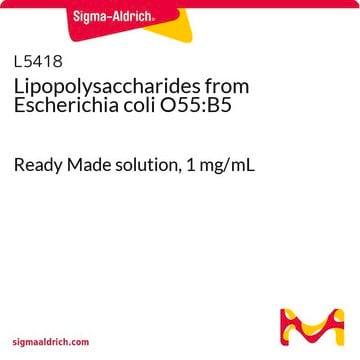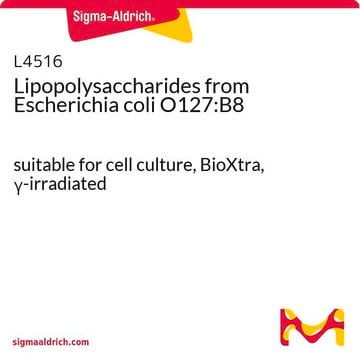L2880
Lipopolysaccharides from Escherichia coli O55:B5
purified by phenol extraction
Synonim(y):
LPS
About This Item
Polecane produkty
pochodzenie biologiczne
Escherichia coli (O55:B5)
Poziom jakości
Postać
lyophilized powder
oczyszczone przez
phenol extraction
metody
cell based assay: suitable
zanieczyszczenia
<3% Protein (Lowry)
kolor
off-white to tan
rozpuszczalność
water: soluble
Zastosowanie
cell analysis
clinical research
life science and biopharma
Warunki transportu
ambient
temp. przechowywania
2-8°C
Szukasz podobnych produktów? Odwiedź Przewodnik dotyczący porównywania produktów
Powiązane kategorie
Opis ogólny
Zastosowanie
- to stimulate hepatocytes and non-parenchymal cells
- to stimulate the spleen and study the expression of the Malitaf gene in the fish blunt snout bream
- as part of the concanavalin A (ConA) and D-galactosamine/lipopolysaccharide (D-GalN/LPS) model of fulminant hepatitis to study the effect of the natural compound hesperetin
- to check the cell viability of human chorionic villi-derived mesenchymal stem cells (hCMSCs) by methyl thiazolyl tetrazolium (MTT) assay
- to induce oligodendrocyte toxicity to evaluate the neuroprotective effects of few compounds
- to induce sarcopenia in rats to evaluate the antioxidant effects of curcumin-loaded hydrophobic surface-modified hydroxyapatite
Działania biochem./fizjol.
Inne uwagi
produkt powiązany
Hasło ostrzegawcze
Danger
Zwroty wskazujące rodzaj zagrożenia
Zwroty wskazujące środki ostrożności
Klasyfikacja zagrożeń
Acute Tox. 2 Oral
Kod klasy składowania
6.1A - Combustible acute toxic Cat. 1 and 2 / very toxic hazardous materials
Klasa zagrożenia wodnego (WGK)
WGK 3
Temperatura zapłonu (°F)
Not applicable
Temperatura zapłonu (°C)
Not applicable
Środki ochrony indywidualnej
Eyeshields, Gloves, type N95 (US)
Certyfikaty analizy (CoA)
Poszukaj Certyfikaty analizy (CoA), wpisując numer partii/serii produktów. Numery serii i partii można znaleźć na etykiecie produktu po słowach „seria” lub „partia”.
Masz już ten produkt?
Dokumenty związane z niedawno zakupionymi produktami zostały zamieszczone w Bibliotece dokumentów.
Klienci oglądali również te produkty
responsiveness is affected by scaffold properties
Produkty
Poznaj strukturę, funkcję i różnorodne zastosowania lipopolisacharydów. Odkryj ich rolę w bakteriach, specyficzność serologiczną i potencjał badawczy.
Explore the structure, function, and diverse applications of Lipopolysaccharides. Discover their role in bacteria, serological specificity, and research potential.
Nasz zespół naukowców ma doświadczenie we wszystkich obszarach badań, w tym w naukach przyrodniczych, materiałoznawstwie, syntezie chemicznej, chromatografii, analityce i wielu innych dziedzinach.
Skontaktuj się z zespołem ds. pomocy technicznej




